Shabbat Around the World
You can learn about them through my unique,
digital-story / lesson-plan series that
It Gets You and Your Students Involved!


There's no denying it. Purim is our noisiest holiday. There's a lot of hissing, stamping, rattling and "groggering" in the synagogue whenever Haman's name comes up in the Megillah. With all the different types of groggers on the market, I can't help wonder how this custom began.
So I Googled it and discovered that its origins can be traced all the way back to the 13th century, when French and German rabbis introduced the custom of writing Haman's name and the names of his sons on two stones in order to bang them together until the names were blotted out.
The reason behind this "madness"? It was their way of literally translating line 19 of Chapter 25 in the book of Deuteronomy which states: "Thous shall blot out the remembrance of Amalek."

Once using stones went out of fashion, some people began to write the names on the bottom of their shoes in order to stamp them out (not a bad idea). Others started using a rattle called a gregar.
I just looked up the word gregar. It's a Romanian word stemming from the Latin word gregarius. Sound familiar? And so appropriate. I can't think of a more social, outgoing Jewish holiday than Purim. And NOISY!
Let the fun begin! Happy Purim.


What name immediately comes to mind when you hear someone say Purim? There are many colorful characters, but be honest. Isn't Esther the one you associate the most with this holiday? She's beautiful, brave and the Megillah is named after her.
Get a load of this. Purim is first mentioned in the book of Maccabees II (15:32) -- three to four centuries after it occurred! All of a sudden, out of nowhere, this holiday appears. The text says that on the 14th day of the month of Adar, Jews celebrated a holiday called "Mordecai Day."
When did the holiday name change to Purim? I've looked and looked. Sadly, I can't find the answer. Still, I think we should focus on the original name. It's a great conversation/class discussion opener.
Mordecai -- the great letter writer (see Chapter 9 of the Megillah) -- is both the producer and director of this story. His actions teach us so many lessons: civics (he saves the king's life); Judaism (one bows only to God, and so he refuses to bow down to Haman); battle strategy (he devises the plan that gets his niece strategically settled in the palace, directing her how to proceed and save her people); celebration (he tells us how to celebrate this holiday); and finally, ethics (he also tells us that we must give gifts to the poor.)
In fact, the second-to-last chapter of the Megillah (Chapter 9) is the best explanation as to why Purim was originally called "Mordecai Day." This year, when you study the megillah, read it first. Our hero is there -- loud and clear. Our main customs for celebrating Purim are there -- written and commanded by...Mordecai, of course.
Happy Mordecai Day.
Tu B'shvat is around the corner. How about creating a poeTREE contest dedicated to trees?
Need inspiration? Have a look at some of Israel's most outstanding trees.
This Atlantic Pistachio tree stands in the Kadesh Valley in the Upper Galillee. It's a true beauty and a great picnic spot.

Olive trees abound in Israel, but this tree located at Ein-Al-Asad on Mount Meron is a special one standing in an old field between two Druze villages.

A tree with true character, this sycamore tree which stands in Netanya, has turned into tree playground!

Finally, a tree growing in the desert. This twisted acacia tree is located near Sede Boker in the Negev -- the Kibbutz that Israel's first prime Minister, David Ben-Gurion, called home.

Want to read more about these trees and see others? Click here.
Now to our poeTREE contest. I'll leave you with another inspiration starting point. It's a perennial penned by Joyce Klime.
I think that I shall never see
A poem lovely as a tree.
A tree whose hungry mouth is prest
Against the earth's sweet flowing breast;
A tree that looks at God all day,
And lifts her leafy arms to pray;
A tree that may in summer wear
A nest of robins in her hair;
Upon whose bosom snow has lain;
Who intimately lives with rain.
Poems are made by fools like me,
But only God can make a tree.

While everyone equates Tu B'Shvat with Arbor Day, there's a social justice side to this holiday that seems to have gotten lost in translation.
Way back, when the Rabbis wrote the Mishna (the first part of the Talmud), Tu B'Shvat marked the beginning of the crop year. By conducting a field study in which they examined plant life in pastures and orchards, the Rabbis concluded that each year's tree growth began on the day the sap started to rise in the trees, and that date just happened to have been Tu B'Shvat -- the fifteenth day of the month of Shvat.
Once this agrarian milestone was established, the rabbis proceeded to determine laws revolving around it. As a result, every year orchard farmers had to measure and set aside a prescribed portion of their crops for a tithe -- a holy gift. This is when the social justice side of Tu B'Shvat kicked in. Farmers were instructed to give a portion of their produce to the Temple, the Levites and the poor -- to the Temple as a holy offering; to the Levites because they were not allowed to be landowners (they were the musicians and gatekeepers of the Temple); and to the poor because Jews were commanded in the Bible to make sure that the needy be fed. Have a look at the Book of Deuteronomy, Chapter 15, sentence 11. It's one of several examples.

While tree planting and holding a Tu B'Shvat Seder are the customs generally found on our radar, this long lost practice may very well be the root of a custom practiced numerous generations ago in Jerusalem's Old City. Back then, Jerusalemites sent Tu B'Shvat Mishloach Manot trays of fruits, nuts and seeds to one another in order to make sure that everyone had enough for their own Tu B'Shvat feast. Fast forward to the 21st Century and I am sure you can find a way to reach out to the needy on Tu B'Shvat. You may want to make a donation to Leket Israel - Israel's National Food Bank. Similarly, maybe it's time to locate your local food bank and lend a helping hand. If you literally want to roll up your sleeves, volunteer at the closest soup kitchen to your home, or help open one at your synagogue. Enjoying choice dried fruits on Tu B'Shvat has greater meaning when one hand feeds the other.

Tu B'Shvat Seder Plate Photo Credit
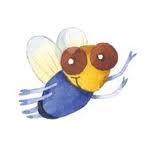 SHALOM!!!!
SHALOM!!!!
It's me again. Zvuvi. And I have a question for you: how many of the English words you use are actually Hebrew?
Hmmm....Want to think about it? Take your time. In the meantime I'm going to put up our alphabet.

Our alphabet is called the Alef Bet.
What's that??? Did I hear you say that the word alphabet sounds like Alef Bet?!?
Ding, Ding, Ding!!!!! You just scored a point because the Alef Bet was around a long time before the word "alphabet" came into being.
What other English words are almost, if not identical to Hebrew words?
How about:
 &
& 
Here's another. It's a Leonard Cohen favorite: 
Too much prayer? Here's a word that's Shabbat related. It's something everyone loves to eat, even people that are not Jewish. The word -- in Hebrew and English -- is right there, on the bottom right corner of this cutting board.

What's that? You say I've got a lot of 

And if you think this is a Yiddish word, you are so wrong! Have a read.
These are only a few "English" words. There are many more.
Why, all of a sudden, am I into this? Because it's Hebrew Language Week in Israel. Tomorrow is the birthday of Eliezer Ben-Yehuda, the father of the modern Hebrew language. Without him, Hebrew would only be the language of the Bible. Thanks to him, it's the language we speak morning, noon and night.
Don't worry. A lot of English words have crept into Hebrew as well. But that's another post.
So, for now...



Hey! I'm back and I'm trying to get my family to enter Israel's latest contest: Best Mid-Week Family Dinner Experience.
Why mid-week? Well...I don't want to sound like I'm boasting, but us Israelis...we're kinda ahead of the game. It doesn't matter if you're religious or not, on Friday night most of us get together for a family meal like this one.

But in Israel's fast paced world -- which is just like yours -- where Moms and Dads are working, working, working, and girls and boys go from school to after-school activities with homework in between, mid-week family time is a big HUH?!? Which is crazy, because we should really spend more time together. It's important!!!! We actually get to talk instead of text, and we get to feel a lot closer to each other. So to make sure we sit around the table as a family, one of Israel's largest food manufacturers -- Osem -- has teamed up with Israel's largest newspaper -- Yediot Ahranot and its online version, Ynet -- to create a contest around mid-week family meals.
Here's what we have to do to enter the contest: we have to send in a report about our eating style, the stories we tell each other around the table, and the recipes for the different dishes making up our meal. We've got two weeks to do this. The best thing about this contest? There won't be one winner. There'll be 5!
Let's see...I'm thinking couscous-tabouli salad...

....and 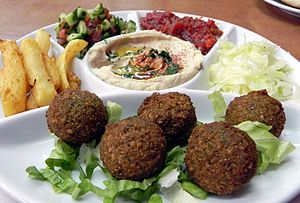
a gourmet (of course!) falafel platter with hummus, chips, Israeli salad and a few more goodies.
I'm telling you, the Zvuvi family is definitely going to fly off with one of the prizes. We're stuck on food -- it's our best landing pad, which is...well...how we get to eat together as a family. And these recipes? While you may want to be a fly on the wall when Israeli chefs exchange ingredient secrets, we're actually there, eating up every morsel of information.
There's no winging it. This time around we're going to cook up a winner and have a lot of buzz fun together.
Gotta go. I'm already drooling.
Family Photo Credit

ShalomYumYum:
It's that time of the year, when my favorite pastimes start with the letter S or ס.
You got it -- Sivivon -- סביבון -- that's Hebrew for dreidel, and Sufganiya -- סופגניה -- Hebrew for jelly doughnut. And yes, I know Hanukkah's about to end, but I'm still spinning with joy.
I love Sufganiyot so much, that today I decided to find out how they became the favorite Hanukkah food over here in Israel.
Here's what I found out: It all began with the North African Jewish tradition of eating Sfenj on Hanukkah -- small, deep fried doughnuts -- like the ones being fried in this photo taken in Morocco.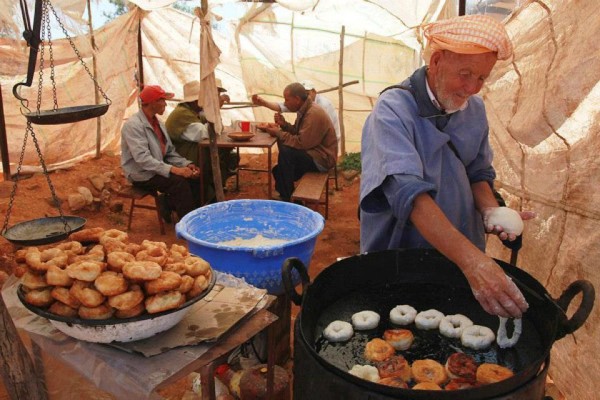
When Jews from Morocco, Algeria, Tunisia, Libya and Egypt (countries in North Africa) moved to Israel and started mixing with Jews from Central and Eastern Europe, they found out about a Yiddish delicacy called Ponchkes, which is like the Russian Ponchik, that looks like this: 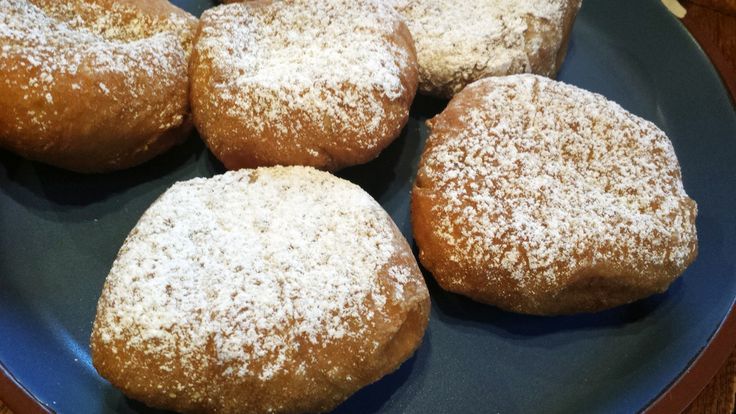
Doesn't look like Ponchiks had any kind of filling, so you can imagine how happy they were to find out about the German Berliner, with jelly dripping out of the side.

Yum-mmmy!!! And now, for the final touch. The combined Israeli nation put all their ingredients into their melting pot -- fried North African Sfenj, Russian Ponckiks and German Berliners -- by taking two circles of dough, sticking them together with a jelly filling and deep frying them into a one piece jelly bun for Hanukkah.
And so the Sufganiyah was born!
What about you? Do you know how Jelly Doughnuts came to America?
Nooooo....not through Dunkin Doughnuts.
I'm going to whet your appetite by starting you off:
One theory is that Dutch settlers invented them, calling them Oliekoek - which literally means means "Oil Cake" -- a sweetened cake fried in fat. Today. I think they're called Oliebollen, and they look like this: 
Now it's your turn. You take it from here.
Did the Dutch really bring jelly doughnuts to America or did combined ethnic American groups cook it up in their melting pot? You gotta watch it. If you're like me, you'll find that research can create an unbelievable appetite!!!!!
Enjoy and let me know what you find out!

Hanukkah -- a holiday for reuse and recycle? Doesn't sound right with all the gifts galore. However, this custom from Kurdistan proves that it's possible.
When it came to celebrating Hanukkah even the poorest Jew in Kurdistan didn't have egg on his/her face. To the contrary! They proved that Hanukkah was everything it's cracked up to be. So what if they couldn't afford a fancy Hanukkiah (Menorah)?! Their children had just as much fun -- perhaps even more -- lighting their homemade versions made out of egg shells. With eggs being a staple in everyone's diet, there were enough cracked eggshells to use as cups for wicks and oil for the required number to light every night.
A simple, fun solution with a lesson in conservation rolled into one. You can't get better than that!
Gift giving on Hanukkah can come in many forms. A back to basics present of two cracked eggshells on the first night will bring a broad smile to everyone's face and set the tone for eight nights of fun.
Happy Hanukkah!

Shalom, Hello, and in Two Weeks' Time -- Happy Hanukkah!
I've decided to give you a quick Hannukah quiz. 
It's fun and interesting. Ready?
Here goes. First a little background: Like the United States, Israel is a melting pot. That means our citizens come from all over the world -- countries in Europe, North America, South America, Africa and Asia.
Now for the question: Which Jewish community never celebrated Hanukkah until its members came to live in Israel?
Want to give a guess? Let's hear your answer.
Want to look up the answer? O.K. You've got 5 minutes.
Zzzzz........

I'm back. What's the answer?
Did I hear you say Jews from Ethiopia? Bing, Bing, Bing, Bing!!!!!! You are so right. But I've got another question and it's related to the first one. How come?
Not sure? Can I help you out?
O.K. Here's the thing: Jewish life in Ethiopia goes back more than 2,500 years. Some people think that the Jews of Ethiopia are descendants of the tribe of Dan -- one of the lost 10 tribes -- and that they escaped Egypt by heading south. Others say that Ethiopian Jews are the descendants of King David and the Queen of Sheba. Whatever the case is, they never heard of the Macabees. They only celebrated holidays mentioned in the Bible.
All of that has changed now that the Jews of Ethiopia live in Israel. Have a look at this beautiful handmade, embroidered picture made by an Ethiopian artist. I love it! I hope you do too.

Thanks for taking my quiz. Bye for now.
Zvuvi

This year you can do it -- put all thoughts of a December Dilemma aside by transforming Hanukkah into an unforgettable family experience. How? It just so happens that I have the solution: follow the multicultural customs appearing in my book Hanukkah Around the World.
This book first appeared in 2009 and it's turned into a perennial because it opens a window to the Hanukkah customs practiced in Australia, Israel, Italy, Turkey, Poland, Uzbekistan, Tunisia and the United States. Each Hanukkah day you can cuddle up for a fun family read of a story revolving around a specific tradition. Find a way to adapt the custom at night when you light your Menorah and try the matching recipes from each country. Trust me. This will be a Hanukkah your children won't forget.
For a different (dreidel) twist, I have another Hanukkah book with an important message.
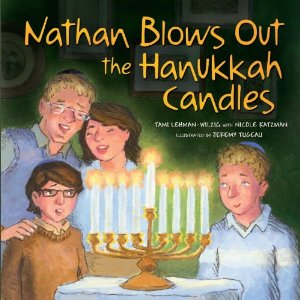
Nathan Blows Out the Hanukkah Candles is an engaging story that shows children how important it is to follow the Jewish value of "accepting the other in your midst." The perfect book to read out loud, it's a conversation opener on the importance of love, understanding and respect of those who are different.
Wishing you the best possible gift this year -- a meaningful, memorable Hanukkah.

Hey! It's me again and I want to tell you that California Governor Jerry Brown is a smart man. His state is suffering from a record-breaking drought and he knows who to turn to for help – Israel. He recently signed a strategic agreement with Prime Minister Netanyahu to bring Israel's famous water specialists to the thirstiest state in America.
I really feel for you California, but don't give up. If we made the desert bloom decades ago, we can help you. Water has always been a major issue over here. We know what it's like not to have rain. In fact, last year we had the driest winter in decades but we don't have a water shortage this year!
How can that be? Simple. We've spent decades researching and developing some of the most advanced water and irrigation technologies in the world. We've also invested in planning our water economy. That includes desalination water recycling.
At this point, we're world water experts. And you know what? California is not the first state to turn to us. Ohio came to us a while back and has been using Israeli water technology to save water and prevent waste for several years.
Massachusetts is another one of our “customers.” That's BIG because the state is home to hundreds of its own water technology companies, and is one of the leaders in the U.S. for developing ingenious water systems. With all that, Massachusetts still turned to us. Its governor – Duvall Patrick – says: “Israel is the world’s top location for water tech start-ups, with innovative technology in fields such as water reuse, wastewater treatment, desalination, energy efficiency, and drip irrigation.”
The governor knows what he's talking about, and so does Jerry Brown. An Israeli expert in groundwater flow systems is in California right now. His name is Professor Eilon Adar and he told the governor: "If we managed to overcome the water issues in the Middle East, we can do it anywhere in the world.”
So don't worry California. Right now you're in deep water but we'll show you how to tap your resources and go with the flow.

In another few weeks we're going to celebrate the next holiday on the Jewish calendar – Hanukkah.
Many of us are accustomed to receiving a gift each night but I just read about one young woman in Massachusetts who has turned this custom around, making it a Tikkun Olam project.
Her name is Maxine Harvey. As long as she can remember, her family collected everything given at their annual Hanukkah party and donated them to local families in need. When a close family friend who happened to be a social worker passed away in 2006, Maxine wanted to create a lasting memorial for her. The way she did it was expand upon her family custom by launching an organization that would collect, store and distribute donated items to needy families. She called her project “Debbie's Treasure Chest.”
When Maxine started this project she was 10 years old! Today she is 18, a freshman at Clark University, and “Debbie's Treasure Chest” is a thriving enterprise with 50,000 different toys, clothing, toiletries, home furnishings and all types of holiday decorations. Maxine reports that 1,500 families have benefitted from “Debbie's Treasure Chest.” She proudly says: “It is great that a small thing like a toy or a toothbrush can mean so much to someone. It is very gratifying to know that.”
Wow!!! What a way to interpret the giving part of Hanukkah. Thank you Maxine for showing us that Hanukkah is not all about me but all about you.

Ooops, I missed it. The Shabbat Project. From what I've read, last week Jews in 350 cities around the world kept it together by all observing Shabbat starting at sundown, Friday night October 24 for 25 hours, ending on Saturday night.
On second thought, I didn't miss it at all. I embrace Shabbat every week. And you know what else? The word “project” sounds heavy. There's a certain flow about Shabbat that eases the mind, at least for me.
Today I remembered two other projects, both held during the month of March. The first one is National Unplugging Day, which coincidentally begins on sundown Friday night and ends – you got it, sundown Saturday night. The second is Shabbat Across America and Canada. I looked it up. This year it's scheduled to begin sundown Friday night March 13, 2015 and it's billed as an event that will turn an ordinary Shabbat into something extraordinary.
Is there something ordinary about Shabbat? Not for me. It's the extraordinary end of every week!
Let me share with you how I discovered that fact. It was (way, way) back, when I was in 7th grade and proving to everyone that I am not a mathematical genius. Tutors came and went. I just couldn't get it. Finally, one tutor got through and prepped me for my next math test. I took it and came out smiling, confident that I had finally earned a passing grade. The test was returned the following Friday. Sure enough, I had done it again. Failed. Totally distraught, I ran to my room as soon as I got home, sat down, took out the test and stared at it for a solid hour while tears streamed down my face.
My mother heard the sobs, told my father, who came in to console me, but not with the words I expected: “Tami,” he said, “you are to put that test away right now. Shabbat starts in five minutes. I don't want you to think about that test at all for the next 25 hours. I want you to read a good book, visit your friends, have a good time, and take a rest from your math misery. That's what Shabbat is all about. Taking a break from all your problems. When it's over take the test out and look at it with fresh eyes. You'll understand where you went wrong.”
Like the Bible says, and so it was. My father showed me the extraordinary side of Shabbat. Ever since then I eagerly await Shabbat. As soon as I light the candles the curtain lifts, and I enter a world of calm and contentment. A world of special customs, songs, food and most important, family time.
What do you think: Should you make a big deal about Shabbat twice a year – or look forward to it every week? Do you need to be told that there's one day a year for unplugging when you can do it on a weekly basis? What are you going to do each Shabbat to unplug?
Are you looking for quiet time with your spouse and/or children? Tell me, what are you doing this Friday night and Saturday? And every Friday night and Saturday thereafter?
Need Some Help? If you're looking for fun and interesting Shabbat customs to incorporate in your weekly Shabbat celebration, get ready for the end of April when I will launch a new story series on my website called Shabbat Around the World.
I'll be posting more info as we get closer to April.

Shalom Girls & Boys:
I don't usually talk about the Torah portion of the week, but I couldn't help notice Chapter 11 of Genesis in this week's section and connect it to where I live – ISRAEL. The Torah section I'm talking about takes place after the flood, after Noah and his family left the ark.
At that point in time everyone spoke the same language and understood each other. They decided to work together and build a very impressive skyscraper. The builders were merrily working their way to the top when God saw what they are doing, and he wasn't happy. Earlier, when their forefathers – Noah's family – left the ark, God told them to multiply, spread out and fill the earth. Now they were building a tower reaching the sky and staying together in the same place. To make sure they fulfill the commandment, God created total confusion by switching each one's language to a different tongue (so to speak). Everyone became discombobulated. They began scratching their heads, not understanding what the next one was saying. They stopped building. Each took his/her family and went on their merry way, filling the earth and multiplying.
So why did I think about modern-day Israel? Because, hey – we've reversed the situation. We're nine million people speaking the same language – Hebrew – while at the same time speaking the language of our forefathers. So you've got families from the United States, Canada, Great Britain, Australia and New Zealand who speak English to each other and their Anglo friends – and in the same accent of the state/region they came from. Then you've got lots and lots of Russians who continue speaking Russian between themselves, just like the Ethiopians continue speaking Gez. And the French? They would NEVER think of giving up speaking French. The same goes for the Italians, Swiss, Germans and you name it. We're one little country with a lot of languages being spoken. BUT we all speak Hebrew between each other when the different cultures mix.
Isn't that just like where you live? Think about your Italian, Greek and Chinese neighbors – or their parents and grandparents. What language do they speak to their family? Not English. But when they speak to you, it's only in English.
Hey! You know what? Sounds like we have a lot in common.
